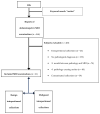Diffusion-Weighted Magnetic Resonance Imaging as a Noninvasive Parameter for Differentiating Benign and Malignant Intraperitoneal Collections
- PMID: 32369983
- PMCID: PMC7279298
- DOI: 10.3390/medicina56050217
Diffusion-Weighted Magnetic Resonance Imaging as a Noninvasive Parameter for Differentiating Benign and Malignant Intraperitoneal Collections
Abstract
Background and Objective: The imaging differentiation of benign from malignant intraperitoneal collections (IPCs) relies on the tumoral morphological modifications of the peritoneum, which are not always advocating for malignancy. We aimed to assess ascitic fluid with the apparent diffusion coefficient (ADC) to determine non-invasive, stand-alone, differentiation criteria for benign and malignant intraperitoneal effusions. Materials and Methods: Sixty-one patients with known IPCs who underwent magnetic resonance examinations for reasons such as tumor staging, undetermined abdominal mass and disease follow up were retrospectively included in this study. All subjects had a final diagnosis of the fluid based on pathological examinations, which were divided into benign (n = 37) and malignant (n = 24) IPCs groups. ADC values were measured separately by two radiologists, and the average values were used for comparing the two groups by consuming the independent samples t-test. The receiver operating characteristic analysis was performed to test the ADC values' diagnostic ability to distinguish malignant from benign collections. Results: The differentiation between benign and malignant IPCs based on ADC values was statistically significant (p = 0.0034). The mean ADC values were higher for the benign (3.543 × 10-3 mm2/s) than for the malignant group (3.057 × 10-3 mm2/s). The optimum ADC cutoff point for the diagnosis of malignant ascites was <3.241 × 10-3 mm2/s, with a sensitivity of 77.78% and a specificity of 80%. Conclusions: ADC represents a noninvasive and reproducible imaging parameter that may help to assess intraperitoneal collections. Although successful in distinguishing malignant from benign IPCs, further research must be conducted in order to certify if the difference in ADC values is a consequence of the physical characteristics of the ascitic fluids or their appurtenance to a certain histopathological group.
Keywords: ascites; diffusion-weighted imaging (DWI); magnetic resonance (MRI); peritoneal carcinomatosis.
Conflict of interest statement
The authors declare no conflict of interest.
Figures




Similar articles
-
Diagnostic value of diffusion-weighted magnetic resonance imaging: differentiation of benign and malignant lymph nodes in different regions of the body.Clin Imaging. 2015 Sep-Oct;39(5):856-62. doi: 10.1016/j.clinimag.2015.05.006. Epub 2015 May 22. Clin Imaging. 2015. PMID: 26091745
-
Diffusion Weighted Imaging for Differentiating Benign from Malignant Orbital Tumors: Diagnostic Performance of the Apparent Diffusion Coefficient Based on Region of Interest Selection Method.Korean J Radiol. 2016 Sep-Oct;17(5):650-6. doi: 10.3348/kjr.2016.17.5.650. Epub 2016 Aug 23. Korean J Radiol. 2016. PMID: 27587953 Free PMC article.
-
Can diffusion-weighted imaging distinguish between benign and malignant pediatric liver tumors?Pediatr Radiol. 2018 Jan;48(1):85-93. doi: 10.1007/s00247-017-3984-9. Epub 2017 Sep 18. Pediatr Radiol. 2018. PMID: 28921384
-
Discrimination between malignant and benign thyroid tumors by diffusion-weighted imaging - A systematic review and meta analysis.Magn Reson Imaging. 2021 Dec;84:41-57. doi: 10.1016/j.mri.2021.09.006. Epub 2021 Sep 21. Magn Reson Imaging. 2021. PMID: 34560233
-
Diagnostic Utility of Diffusion-Weighted Imaging and Apparent Diffusion Coefficient for Common Orbital Lesions: A Review.Ophthalmic Plast Reconstr Surg. 2022 Nov-Dec 01;38(6):515-521. doi: 10.1097/IOP.0000000000002092. Ophthalmic Plast Reconstr Surg. 2022. PMID: 34798654
Cited by
-
Comparison of Linear and Convex-Array Transducers in Assessing the Enhancement Characteristics of Suspicious Breast Lesions at Contrast-Enhanced Ultrasound (CEUS).Diagnostics (Basel). 2022 Mar 24;12(4):798. doi: 10.3390/diagnostics12040798. Diagnostics (Basel). 2022. PMID: 35453846 Free PMC article.
-
Possible use of 2D shear wave liver elastography in new-onset ascites evaluation.BMC Gastroenterol. 2024 Feb 8;24(1):68. doi: 10.1186/s12876-024-03159-1. BMC Gastroenterol. 2024. PMID: 38331713 Free PMC article.
-
Research progress and treatment status of malignant ascites.Front Oncol. 2024 Dec 16;14:1390426. doi: 10.3389/fonc.2024.1390426. eCollection 2024. Front Oncol. 2024. PMID: 39737405 Free PMC article. Review.
-
CT-Based Radiomic Analysis May Predict Bacteriological Features of Infected Intraperitoneal Fluid Collections after Gastric Cancer Surgery.Healthcare (Basel). 2022 Jul 10;10(7):1280. doi: 10.3390/healthcare10071280. Healthcare (Basel). 2022. PMID: 35885807 Free PMC article.
-
Quantitative MRI of Pancreatic Cystic Lesions: A New Diagnostic Approach.Healthcare (Basel). 2022 Jun 2;10(6):1039. doi: 10.3390/healthcare10061039. Healthcare (Basel). 2022. PMID: 35742090 Free PMC article.
References
-
- Singh S., Devi Y.S., Bhalothia S., Gunasekaran V. Peritoneal Carcinomatosis: Pictorial Review of Computed Tomography Findings. Int. J. Adv. Res. 2016;4:735–748. doi: 10.21474/IJAR01/936. - DOI
-
- Marin D., Catalano C., Baski M., Di Martino M., Geiger D., Di Giorgio A., Sibio S., Passariello R. 64-Section multi-detector row CT in the preoperative diagnosis of peritoneal carcinomatosis: Correlation with histopathological findings. Abdom. Imaging. 2010;35:694–700. doi: 10.1007/s00261-008-9464-9. - DOI - PubMed
MeSH terms
LinkOut - more resources
Full Text Sources
Medical

